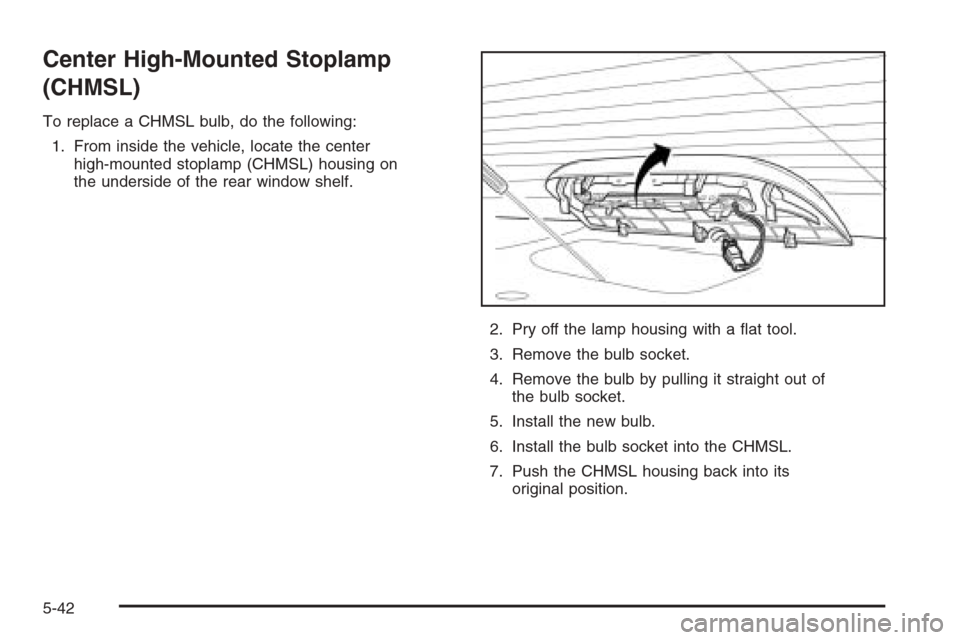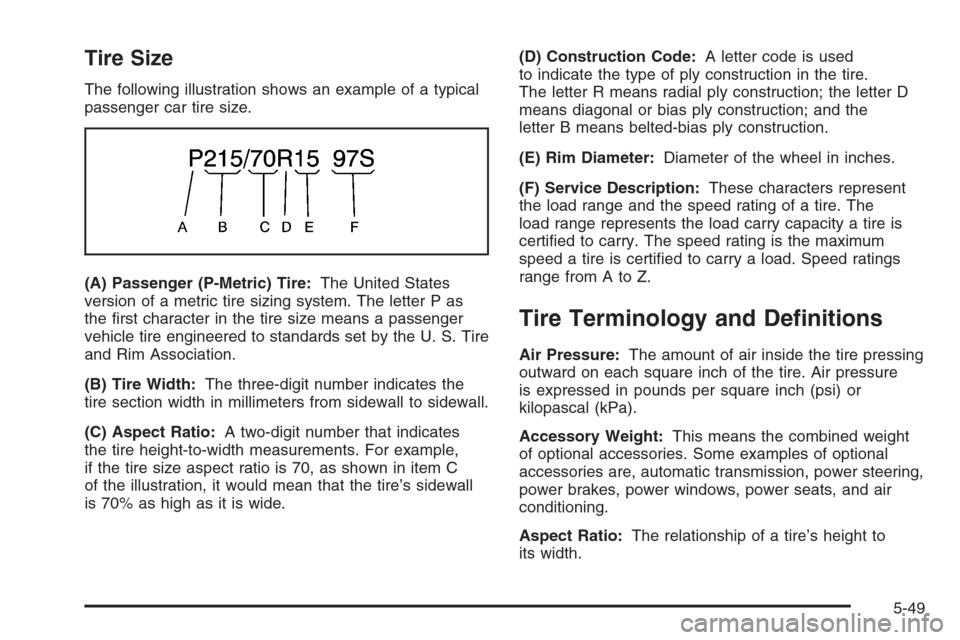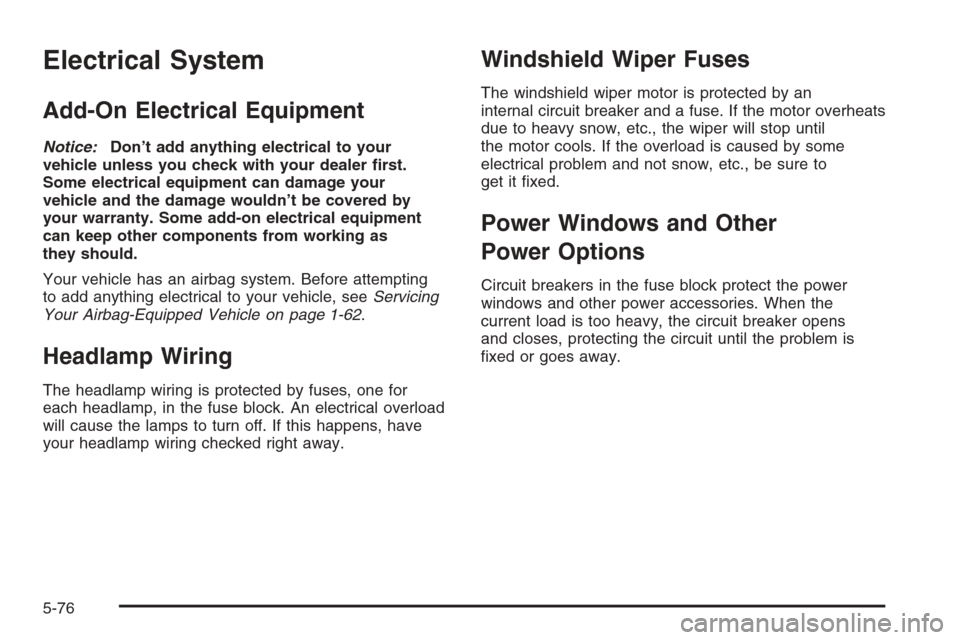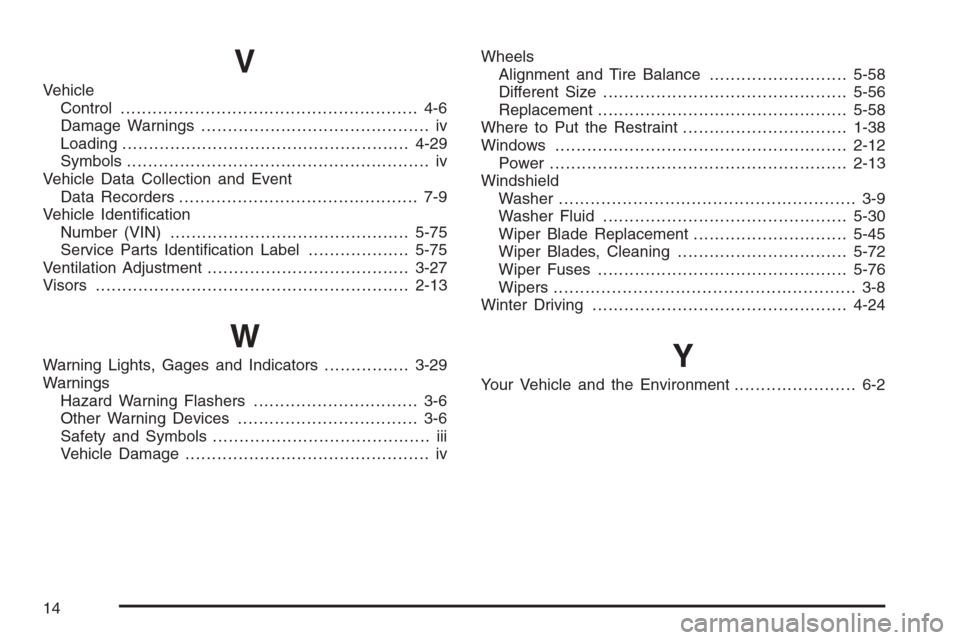2006 CHEVROLET EPICA window
[x] Cancel search: windowPage 266 of 368

Center High-Mounted Stoplamp
(CHMSL)
To replace a CHMSL bulb, do the following:
1. From inside the vehicle, locate the center
high-mounted stoplamp (CHMSL) housing on
the underside of the rear window shelf.
2. Pry off the lamp housing with a flat tool.
3. Remove the bulb socket.
4. Remove the bulb by pulling it straight out of
the bulb socket.
5. Install the new bulb.
6. Install the bulb socket into the CHMSL.
7. Push the CHMSL housing back into its
original position.
5-42
Page 273 of 368

Tire Size
The following illustration shows an example of a typical
passenger car tire size.
(A) Passenger (P-Metric) Tire:The United States
version of a metric tire sizing system. The letter P as
the first character in the tire size means a passenger
vehicle tire engineered to standards set by the U. S. Tire
and Rim Association.
(B) Tire Width:The three-digit number indicates the
tire section width in millimeters from sidewall to sidewall.
(C) Aspect Ratio:A two-digit number that indicates
the tire height-to-width measurements. For example,
if the tire size aspect ratio is 70, as shown in item C
of the illustration, it would mean that the tire’s sidewall
is 70% as high as it is wide.(D) Construction Code:A letter code is used
to indicate the type of ply construction in the tire.
The letter R means radial ply construction; the letter D
means diagonal or bias ply construction; and the
letter B means belted-bias ply construction.
(E) Rim Diameter:Diameter of the wheel in inches.
(F) Service Description:These characters represent
the load range and the speed rating of a tire. The
load range represents the load carry capacity a tire is
certified to carry. The speed rating is the maximum
speed a tire is certified to carry a load. Speed ratings
range from A to Z.
Tire Terminology and De�nitions
Air Pressure:The amount of air inside the tire pressing
outward on each square inch of the tire. Air pressure
is expressed in pounds per square inch (psi) or
kilopascal (kPa).
Accessory Weight:This means the combined weight
of optional accessories. Some examples of optional
accessories are, automatic transmission, power steering,
power brakes, power windows, power seats, and air
conditioning.
Aspect Ratio:The relationship of a tire’s height to
its width.
5-49
Page 292 of 368

Appearance Care
Cleaning the Inside of Your Vehicle
Your vehicle’s interior will continue to look its best if it is
cleaned often. Although not always visible, dust and dirt
can accumulate on your upholstery. Dirt can damage
carpet, fabric, leather, and plastic surfaces. Regular
vacuuming is recommended to remove particles from
your upholstery. It is important to keep your upholstery
from becoming and remaining heavily soiled. Soils
should be removed as quickly as possible. Your vehicle’s
interior may experience extremes of heat that could
cause stains to set rapidly.
Lighter colored interiors may require more frequent
cleaning. Use care because newspapers and garments
that transfer color to your home furnishings may also
transfer color to your vehicle’s interior.
When cleaning your vehicle’s interior, only use cleaners
specifically designed for the surfaces being cleaned.
Permanent damage may result from using cleaners on
surfaces for which they were not intended. Use glass
cleaner only on glass. Remove any accidental over-spray
from other surfaces immediately. To prevent over-spray,
apply cleaner directly to the cleaning cloth.Notice:If you use abrasive cleaners when cleaning
glass surfaces on your vehicle, you could scratch
the glass and/or cause damage to the integrated
radio antenna and the rear window defogger. When
cleaning the glass on your vehicle, use only a
soft cloth and glass cleaner.
Many cleaners contain solvents that may become
concentrated in your vehicle’s breathing space. Before
using cleaners, read and adhere to all safety instructions
on the label. While cleaning your vehicle’s interior,
maintain adequate ventilation by opening your vehicle’s
doors and windows.
Dust may be removed from small buttons and knobs
using a small brush with soft bristles.
Your GM dealer has a product for cleaning your
vehicle’s glass. Should it become necessary, you can
also obtain a product from your GM dealer to remove
odors from your vehicle’s upholstery.
Do not clean your vehicle using the following cleaners
or techniques:
•Never use a knife or any other sharp object to
remove a soil from any interior surface.
•Never use a stiff brush. It can cause damage to
your vehicle’s interior surfaces.
5-68
Page 300 of 368

Electrical System
Add-On Electrical Equipment
Notice:Don’t add anything electrical to your
vehicle unless you check with your dealer �rst.
Some electrical equipment can damage your
vehicle and the damage wouldn’t be covered by
your warranty. Some add-on electrical equipment
can keep other components from working as
they should.
Your vehicle has an airbag system. Before attempting
to add anything electrical to your vehicle, seeServicing
Your Airbag-Equipped Vehicle on page 1-62.
Headlamp Wiring
The headlamp wiring is protected by fuses, one for
each headlamp, in the fuse block. An electrical overload
will cause the lamps to turn off. If this happens, have
your headlamp wiring checked right away.
Windshield Wiper Fuses
The windshield wiper motor is protected by an
internal circuit breaker and a fuse. If the motor overheats
due to heavy snow, etc., the wiper will stop until
the motor cools. If the overload is caused by some
electrical problem and not snow, etc., be sure to
get it fixed.
Power Windows and Other
Power Options
Circuit breakers in the fuse block protect the power
windows and other power accessories. When the
current load is too heavy, the circuit breaker opens
and closes, protecting the circuit until the problem is
fixed or goes away.
5-76
Page 306 of 368

Fuses Usage
PWR/SEAT Front Power Seat
S/ROOF Sunroof
ECM 1Engine Control Module (ECM),
Transmission Control Module (TCM),
Engine Main Relay
SPARE Spare
SPARE Spare
SPARE Spare
SPARE Spare
SPARE Spare
PWR WNDW Power Window
FUSE PLR Fuse PullerRelays Usage
COOL FAN HI Electric Cooling Fan High Speed
A/C CMPRSR Air Conditioning Compressor
HEAD LAMP Headlamp
COOL FAN
CNTRLElectric Cooling Fan Control
FRT FOG Front Fog Lamp
HORN Horn
ILLUM LAMPS Taillamp
FUEL PUMP Fuel Pump
COOL FAN
LOWElectric Cooling Fan Low Speed
PWR WNDW Power Window
ENG MAINEngine Control Module (ECM),
Ignition Coil
5-82
Page 358 of 368

Customer Assistance Information (cont.)
Customer Assistance Offices........................... 7-4
Customer Satisfaction Procedure..................... 7-2
GM Mobility Reimbursement Program............... 7-5
Reporting Safety Defects to
General Motors........................................7-14
Reporting Safety Defects to the
Canadian Government..............................7-14
Reporting Safety Defects to the
United States Government.........................7-13
Roadside Assistance Program......................... 7-6
Service Publications Ordering Information........7-14
D
Daytime Running Lamps..................................3-13
Daytime Running Lamps Indicator Light.............3-44
Defensive Driving............................................. 4-2
Doing Your Own Service Work........................... 5-4
Dome Lamp ...................................................3-15
Door
Ajar Light...................................................3-44
Central Door Unlocking System....................... 2-8
Door Ajar Reminder....................................... 2-9
Locks.......................................................... 2-7
Power Door Locks......................................... 2-8
Rear Door Security Locks............................... 2-9Driver
Position, Safety Belt.....................................1-15
Seat Tilt Adjuster........................................... 1-3
Driving
At Night.....................................................4-16
City ...........................................................4-19
Defensive..................................................... 4-2
Drunken....................................................... 4-3
Freeway.....................................................4-20
Hill and Mountain Roads..............................4-22
In Rain and on Wet Roads...........................4-17
Rocking Your Vehicle to Get it Out.................4-28
Winter........................................................4-24E
Electrical System
Add-On Equipment......................................5-76
Engine Compartment Fuse Block...................5-79
Fuses and Circuit Breakers...........................5-77
Headlamp Wiring.........................................5-76
Instrument Panel Fuse Block.........................5-77
Power Windows and Other Power Options......5-76
Windshield Wiper Fuses...............................5-76
Engine
Air Cleaner/Filter.........................................5-17
Battery.......................................................5-34
4
Page 364 of 368

Parking
Brake........................................................2-25
Over Things That Burn.................................2-29
Part A - Scheduled Maintenance Services............. 6-4
Part B - Owner Checks and Services.................6-19
Part C - Periodic Maintenance Inspections..........6-23
Part D - Recommended Fluids and Lubricants.....6-25
Part E - Maintenance Record............................6-27
Passenger Airbag Status Indicator.....................3-33
Passenger Compartment Air Filter.....................3-28
Passenger Sensing System..............................1-58
Passing.........................................................4-13
Power
Accessory Outlet(s)......................................3-16
Door Locks.................................................. 2-8
Electrical System.........................................5-76
Seat ............................................................ 1-3
Steering Fluid.............................................5-29
Windows....................................................2-13
Pretensioners, Safety Belt................................1-27
Q
Questions and Answers About Safety Belts.........1-14
R
Radios..........................................................3-46
Care of Your CD Player...............................3-80
Care of Your CDs ........................................3-80
Radio with CD............................3-48, 3-52, 3-59
Radio with Six-Disc CD................................3-67
Trunk-Mounted CD Changer..........................3-75
Understanding Reception..............................3-79
Rear Door Security Locks.................................. 2-9
Rear Seat Armrest..........................................2-35
Rear Seat Operation......................................... 1-8
Rear Seat Passengers, Safety Belts..................1-23
Rearview Mirror, Automatic Dimming..................2-31
Rearview Mirrors.............................................2-31
Reclining Seatbacks.......................................... 1-4
Recreational Vehicle Towing.............................4-33
Remote Keyless Entry System............................ 2-3
Remote Keyless Entry System, Operation............ 2-4
Removing the Flat Tire and Installing the
Spare Tire..................................................5-63
Removing the Spare Tire and Tools...................5-62
Replacement Bulbs.........................................5-44
10
Page 368 of 368

V
Vehicle
Control........................................................ 4-6
Damage Warnings........................................... iv
Loading......................................................4-29
Symbols......................................................... iv
Vehicle Data Collection and Event
Data Recorders............................................. 7-9
Vehicle Identification
Number (VIN).............................................5-75
Service Parts Identification Label...................5-75
Ventilation Adjustment......................................3-27
Visors...........................................................2-13
W
Warning Lights, Gages and Indicators................3-29
Warnings
Hazard Warning Flashers............................... 3-6
Other Warning Devices.................................. 3-6
Safety and Symbols......................................... iii
Vehicle Damage.............................................. ivWheels
Alignment and Tire Balance..........................5-58
Different Size..............................................5-56
Replacement...............................................5-58
Where to Put the Restraint...............................1-38
Windows.......................................................2-12
Power ........................................................2-13
Windshield
Washer........................................................ 3-9
Washer Fluid..............................................5-30
Wiper Blade Replacement.............................5-45
Wiper Blades, Cleaning................................5-72
Wiper Fuses...............................................5-76
Wipers......................................................... 3-8
Winter Driving................................................4-24Y
Your Vehicle and the Environment....................... 6-2
14